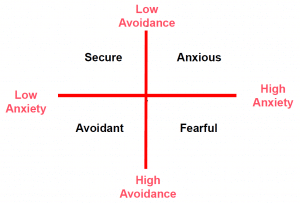Have you ever thought about why you seem to be the clingy one in the relationship? Why you tend shy away from asking for support? Why you avoid intimacy/closeness? Or simply why you’re self-confident and are able to seek support from your partner? Well, the four attachment theories help explain these defining features in relationships.
Attachment theory was first discovered in the 1960’s by John Bowlby and Mary Ainsworth. Bowlby and Ainsworth first studied attachment theory on infants and young children with their caregiver. Attachment styles in infancy and teen years are different then in adult relationships. Adult attachment styles are based on the expectations of the partners’ responsiveness (Bradbury & Karney, 2013).

Above is a picture that describes the overarching idea of what the four attachment styles are. Here is a breakdown of it:
- Avoidant in this context, is indicated as low or high avoidance, which helps to identify whether the individual is comfortable on being dependent on others and having others to depend on.
- Anxiety in this context, is indicated as either low or high anxiety, which helps to identify whether the individual is comfortable being alone or not.
Secure Attachment
An individual who has a “secure attachment” is someone who has low anxiety and low avoidance. Securely attached individuals tend to be more satisfied with their relationship as they’re self-confident to be independent in their relationship and to be intimate with their partner. When they’re in a state of distress, they’re comfortable with seeking out support from their partner and others, which in turn allows their partner to move freely by themselves.
Secure adults are coherent and realistic in discussing any concerns and misunderstandings with their partner, and are able to offer support to their partner when they’re distressed. The outcomes of being a securely attached individual are having relatively good personal and social adjustment. An example of good social adjustment would be being able to adjust to various social events. Another outcome would be having a stable and good quality relationship with others around you, which includes family members, friends, coworkers, and acquaintances.
Having a secure attachment is the best attachment style to have not only in adult relationships, but also the relationship between a child and their caregiver.
Anxious Attachment
Unlike securely attached individuals/couples, anxiously attached individuals are people who have high anxiety and low avoidance. Anxiously attached individuals are quite the opposite to securely attached individuals as they’re clingy to their partner, which means that they’re quite demanding when it comes to closeness, attention, and approval from their partner (Bradbury & Karney, 2013). Because of these actions, they may have low self-worth. Also, when the individual is distressed, they’re heavily reliant on others for support. As a result, these individuals develop their confidence and self-worth through their partners’ responsiveness and attention they provide.
Unlike the outcome of being securely attached, anxiously attached individuals are quite the opposite when it comes to personal and social adjustment. They relatively have poor personal and social adjustment. Therefore, when they’re faced with loss/rejection, they usually are quite quick to find out the source of loss/rejection. Another outcome is that they usually face interpersonal problems, such as intrusiveness, being demanding, dominating, and are overly disclosing with their partner and others.
Avoidant Attachment
People with avoidant attachment styles have low anxiety, but high avoidances. These individuals have very high self-worth, which often means they often express for independence. However, when they’re in need of help when distressed, they tend to avoid seeking out support from their partner and others.
People with avoidant attachment styles don’t really value the importance of close relationships, instead they value self-reliance. One of the outcomes of this attachment style is that individuals are generally good with personal and social adjustment. However, when they’re faced with problem, they tend to distance themselves from any form of intimacy with their partner.
Fearful Attachment
People with fearful attachment styles have high anxiety and high avoidance. Bradbury and Karney (2013) identifies that for individuals with this attachment style, they have high anxiety, which means they’re hypersensitive to potential hurt and rejection. Along with this, they’re highly avoidant, which means that they withdraw use withdrawal as a coping mechanism. Overall, individuals with this attachment style go through highs and lows because they fear being abandoned and alone, but also fear the close and intimate relationship with their partner.
Individuals with fearful attachment are unsure of themselves, non-defensive, and are self-protective. One of the outcomes of this attachment style is that individuals are generally have poor personal and social adjustment. Like avoidant attached individuals, they face interpersonal problems, such as shyness, they’re unassertive, and have difficulty expressing their feelings to their partner. These characteristics normally explain why individuals who have this attachment style avoid closeness from their partner.
Keep in mind that people’s attachment styles can vary between the four and may have characteristics from a few of these attachment styles. That being said, depending on the individual, one’s attachment style can change overtime.
We hope that this article gave some insight and a general understanding on what the four different attachment styles are, and how it affects relationships. Leave us a comment below what you think of this article!
Sources
Bradbury, T. N., & Karney, B. R. (2013). Intimate Relationships. New York, NY: W.W Norton

